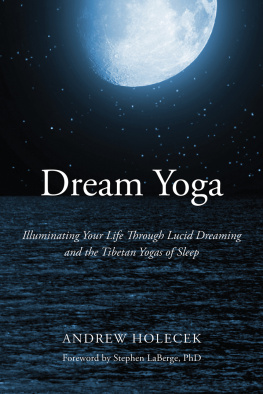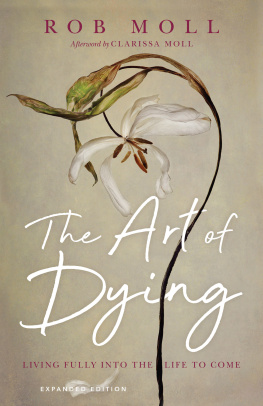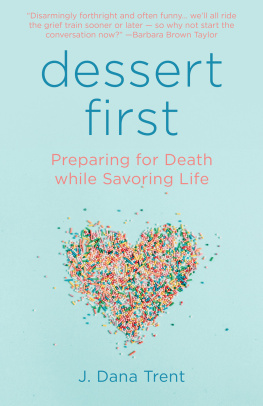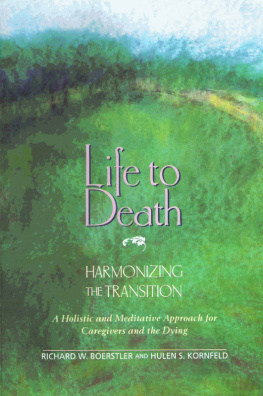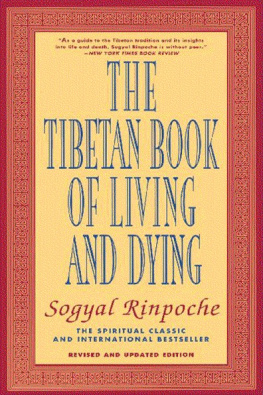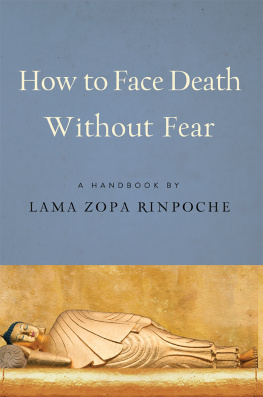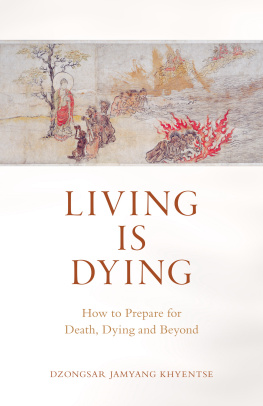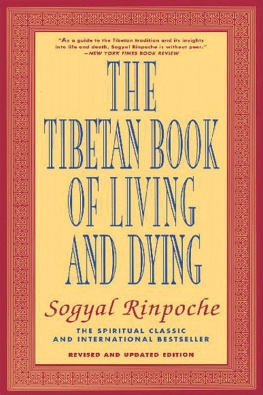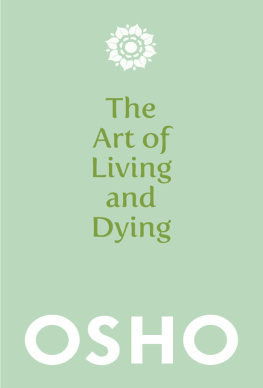If we really want to include something as overwhelming as dying in our spiritual path, we need a way to gradually get closer to the reality. Preparing to Die will help us do that. It offers generous spiritual and practical guidance to help us develop confidence and compassion wherever there is fearour own or othersconfronting death. A significant contribution to the continued transplantation of the Buddhas wisdom in Western culture. May all beings benefit!
Dzogchen Ponlop Rinpoche, author of Mind Beyond Death
A welcome addition to the literature on the Buddhist approach to death and dying. What is remarkable about this book is the way that Holecek intermingles profound spiritual insights with practical and up-to-date advice for people facing death or taking care of those who are dying.
Judith L. Lief, author of Making Friends with Death
There is much in this book that will appeal to anyone who has an open mind and is interested in a non-materialistic approach to death. Particularly inspiring is the heart-advice drawn from interviews with Tibetan masters, all of whom emphasize the fundamental importance of ones state of mind: for those who are dying, letting go, and for those who attend them, love.
Francesca Fremantle, translator of The Tibetan Book of the Dead
ABOUT THE BOOK
We all face death, but how many of us are actually ready for it? Whether our own death or that of a loved one comes first, how prepared are we, spiritually or practically? In Preparing to Die, Andrew Holecek presents a wide array of resources to help the reader address this unfinished business.
Part One shows how to prepare ones mind and how to help others, before, during, and after death. The author explains how spiritual preparation for death can completely transform our relationship to the end of life, dissolving our fear and helping us to feel open and receptive to letting go in the dying process. Daily meditation practices, the stages of dying and how to work with them, and after-death experiences are all detailed in ways that will be particularly helpful for those with an interest in Tibetan Buddhism and in Tibetan approaches to conscious dying.
Part Two addresses the practical issues that surround death. Experts in grief, hospice, the funeral business, and the medical and legal issues of death contribute chapters to prepare the reader for every practical concern, including advance directives, green funerals, the signs of death, warnings about the funeral industry, the stages of grief, and practical care for the dying.
Part Three contains heart-advice from twenty of the best-known Tibetan Buddhist masters now teaching in the West. These brief interviews provide words of solace and wisdom to guide the dying and their caregivers during this challenging time. Preparing to Die is for anyone interested in learning how to prepare for death from a Buddhist perspective, both spiritually and practically. It is also for those who want to learn how to help someone else who is dying, both during the time of illness and death as well as after death.
ANDREW HOLECEK is an in-demand teacher of Tibetan Buddhism who teaches seminars throughout the country on spiritual hardship and the Tibetan views of life, death, and beyond. He is affiliated with Shambhala centers worldwide and was adjunct faculty at Naropa University and the Ngedon School of Buddhist Studies. He is also the cofounder of Global Dental Relief, which serves impoverished children in five Asian and Central American countries.
Sign up to receive weekly Tibetan Dharma teachings via e-mail.

Or visit us online to sign up at shambhala.com/edharmaquotes.
Preparing to Die

Practical Advice and Spiritual Wisdom from the Tibetan Buddhist Tradition
Andrew Holecek
SNOW LION
BOSTON & LONDON
2013
Snow Lion
An imprint of Shambhala Publications, Inc.
Horticultural Hall
300 Massachusetts Avenue
Boston, Massachusetts 02115
www.shambhala.com
2013 by Andrew Holecek
Cover design by Jim Zaccaria
All rights reserved. No part of this book may be reproduced in any form or by any means, electronic or mechanical, including photocopying, recording, or by any information storage and retrieval system, without permission in writing from the publisher.
Excerpts from The Tibetan Book of the Dead, translated with commentary by Francesca Fremantle and Chgyam Trungpa, 1975 by Francesca Fremantle and Chgyam Trungpa. Reprinted by arrangement with Shambhala Publications, Inc., Boston, MA. www.shambhala.com.
Excerpts from The Tibetan Book of Living and Dying by Sogyal Rinpoche, edited by Patrick Gaffney and Andrew Harvey. Copyright 1993 by Rigpa Fellowship. Reprinted by permission of HarperCollins Publishers.
Excerpts from Glimpse After Glimpse: Daily Reflections on Livingand Dying by Sogyal Rinpoche. Copyright 1995 by Sogyal Rinpoche. Reprinted by permission of HarperCollins Publishers.
Excerpts from Facing Death and Finding Hope by Christine Longaker, copyright 1997 by Christine Longaker and Rigpa Fellowship. Used by permission of Doubleday, a division of Random House, Inc.
Library of Congress Cataloging-in-Publication data
Holecek, Andrew, 1955
Preparing to die: practical advice and spiritual wisdom from the Tibetan Buddhist tradition / Andrew Holecek.
pages cm
eISBN 978-0-8348-2897-1
ISBN 978-1-55939-408-6 (pbk.)
1. DeathReligious aspectsBuddhism. 2. DeathHandbooks, manuals, etc. I. Title.
BQ4487.H65 2013
294.3423dc23
2012049001
This book is dedicated to the Venerable Thrangu Rinpoche
and Khenpo Tsltrim Gyamtso Rinpoche,
who showed me that death is an illusion.
And to my parents, whose deaths showed me
the heartbreak of illusion.
CONTENTS

ILLUSTRATIONS

FIGURES
TABLES

L IFE IS a revolving wheel of existencea chain of endless birth, life, death, and rebirth. If we can train our minds to be peaceful and loving, then whatever we say and do will naturally turn into healthy and beneficial words and deeds for ourselves and others. And then when we die, the experiences that we will have in the bardo and in our next life will, according to Buddhism, also be the same. This is because our experiences are the fruits of the habitual seeds we have sown in our mental soil of the past.
Therefore, while we are alive, we must train our mind with prayers, meditations, and caring for others. Visualize, feel, and believe that we are in front of the Buddha of Loving-Kindness, with his all-knowing wisdom and unconditional love, in a heavenly world of light, peace, and joy. Then sing prayers with devotionwith the energy of joy and trustto the Buddha. Sing with loving-kindnesswishing joy for all sentient beings. The result will be that after death, and in our next life, the world that will appear to us will be a pure land of peace and joy. It will be the manifestation of the positive habits that we implanted in our mind stream during our meditations. For after death, no physical objects follow us. Its only our mindsour mental habitsthat follow us.
Next page

